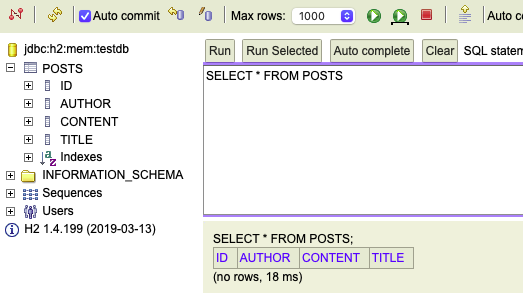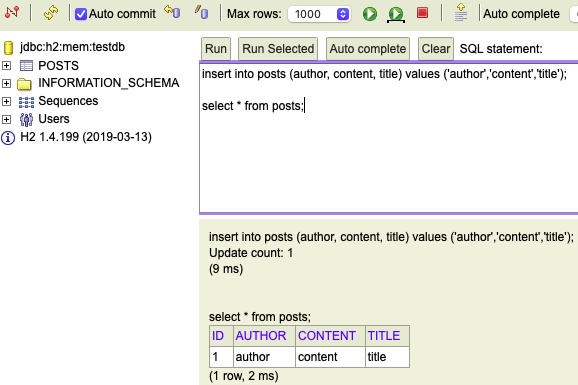이전 포스팅에서 도메인 모델이 가지는 역할에대해 알아보았습니다.
이 도메인 모델을 기억하고 등록 수정 조회 기능을 만들어보겠습니다.
등록
PostsApiController.java
@RequiredArgsConstructor // 생성자 생성
@RestController
public class PostsApiController {
private final PostsService postsService;
@PostMapping("/api/v1/posts")
public Long save(@RequestBody PostsSaveRequestDto requestDto){
return postsService.save(requestDto);
}
}@Controller와 @RestController는 모두 컨트롤러를 지정해줍니다.
다만 차이점은 @RestController는 @Controller에 @ResponseBody가 추가된 것으로 @ResponseBody를 하위 메소드마다 따로 붙이지 않아도 JSon형태로 객체를 전송할 수 있습니다.
PostsService.java
@RequiredArgsConstructor
@Service
public class PostsService {
private final PostsRepository postsRepository;
@Transactional
public Long save (PostsSaveRequestDto requestDto){
return postsRepository.save(requestDto.toEntity()).getId();
}
}controller와 service에서는 Bean주입을 Autowired로 받지 않고 생성자로 주입을 받았습니다.
이와 관련된 포스팅은 생성자주입을 사용하는 이유에서 자세히 볼 수 있습니다.
롬복의 @RequiredArgsConstructor를 통해 final이 선언된 모든 필드에 대해 생성자를 생성해줍니다.
PostsSaveRequestDto.java
@Getter @NoArgsConstructor
public class PostsSaveRequestDto {
private String title;
private String content;
private String author;
@Builder
public PostsSaveRequestDto(String title, String content, String author) {
this.title = title;
this.content = content;
this.author = author;
}
public Posts toEntity() {
return Posts.builder()
.title(title)
.content(content)
.author(author)
.build();
}
}위 Dto는 Entity클래스와 굉장히 유사합니다.
하지만 Entity클래스와 유사하다고 Entity클래스를 Response/Request로 함께 사용하면 안됩니다.
Entity클래스는 데이터베이스와 굉장히 밀접한 클래스이기 때문에 Entity클래스를 기반으로 데이터베이스 테이블이 생성되고 스키마가 변경됩니다.
즉 Entity클래스를 기준으로 여러 비즈니스 로직들이 작동을 하는데,
Response/Request용 Dto는 View를 위한 클래스라 많은 변경이 이루어져야합니다.
Entity클래스를 Dto와 함께 사용하면 테이블도 잦은 변경이 이루어지게 될것이며 이는 다른 비즈니스 로직에도 영향을 미칠 수 있습니다.
그래서 View Layer와 DB Layer는 철저히 분리가 되어야합니다.
등록 테스트
등록 기능을 테스트해보겠습니다.
@RunWith(SpringRunner.class)
@SpringBootTest(webEnvironment = SpringBootTest.WebEnvironment.RANDOM_PORT) // 랜덤포트실행
public class PostsApiControllerTest {
@LocalServerPort
private int port;
@Autowired
private TestRestTemplate restTemplate;
@Autowired
private PostsRepository postsRepository;
@After
public void tearDown() throws Exception {
postsRepository.deleteAll();
}
@Test
public void Posts가_등록된다() throws Exception {
//given
String title = "테스트 제목입니다.";
String content = "테스트 내용입니다.";
PostsSaveRequestDto requestDto = PostsSaveRequestDto.builder()
.content(content)
.title(title)
.author("작성자")
.build();
String url = "http://localhost:"+ port + "/api/v1/posts";
//when
ResponseEntity<Long> responseEntity = restTemplate.postForEntity(url, requestDto, Long.class);
//then
assertThat(responseEntity.getStatusCode()).isEqualTo(HttpStatus.OK);
assertThat(responseEntity.getBody()).isGreaterThan(0L);
List<Posts> all = postsRepository.findAll();
assertThat(all.get(0).getTitle()).isEqualTo(title);
assertThat(all.get(0).getContent()).isEqualTo(content);
}
}ResponseEntity는 요청과 응답에 해당하는 HttpHeader와 HttpBody를 포함하고 있는 클래스인 HttpEntity를 상속받아 구현된 클래스입니다.
따라서 ResponseEntity는 HttpStatus, HttpHeaders, HttpBody를 포함하고 있고, 이 요청은 RestTemplate를 사용해 RESTful원칙을 지켜 HTTP서버와 통신하여 테스트의 결과를 확인 할 수 있습니다.
이와 관련한 자세한 내용은 추후 기술하겠습니다.
 랜덤 포트 실행가 실행되면서 테스트를 통과했습니다.
랜덤 포트 실행가 실행되면서 테스트를 통과했습니다.
수정 / 조회
PostsApiController.java
수정은 PUT, 조회는 GET 메소드를 정의해 다음과 같은 코드를 추가했습니다.
@PutMapping("/api/v1/posts/{id}") // 수정
public Long update(@PathVariable Long id, @RequestBody PostsUpdateRequestDto requestDto){
return postsService.update(id, requestDto);
}
@GetMapping ("/api/v1/posts/{id}") // 조회
public PostsResponseDto findById (@PathVariable Long id){
return postsService.findById(id);
}수정과 조회를 할 때는 id에 맞는 게시글만을 출력할 것이므로 @PathVariable를 사용해 id를 따로 받아왔습니다.
PostResponseDto.java
@Getter
public class PostsResponseDto {
private Long id;
private String title;
private String content;
private String author;
public PostsResponseDto(Posts entity) {
this.id = entity.getId();
this.title = entity.getTitle();
this.content = entity.getContent();
this.author = entity.getAuthor();
}
}응답을 받을 dto를 만들었습니다.
여기서 주의할 점은 entity를 받아서 처리했다는 것입니다.
PostsUpdateRequestDto.java
@Getter
@NoArgsConstructor
public class PostsUpdateRequestDto {
private String title;
private String content;
@Builder
public PostsUpdateRequestDto(String title, String content) {
this.title = title;
this.content = content;
}
}Posts.java
public void update (String title, String content){
this.title = title;
this.content = content;
}수정 시 작성자는 수정할 필요가 없기때문에 제목과 내용 필드만을 작성합니다.
PostService.java
@Transactional
public Long update(Long id, PostsUpdateRequestDto requestDto) {
Posts posts = postsRepository.findById(id).orElseThrow(() -> new IllegalArgumentException("해당 게시글이 없습니다. id =" + id));
posts.update(requestDto.getTitle(), requestDto.getContent());
return id;
}
public PostsResponseDto findById(Long id) {
Posts entity = postsRepository.findById(id).orElseThrow(() -> new IllegalArgumentException("해당 게시글이 없습니다. id =" + id));
return new PostsResponseDto(entity);
} update와 findById의 첫째줄이 동일하게 작성되어있습니다.
이 라인은 id를 데이터 베이스에서 찾을 수 없을때 예외를 발생시키는 문장입니다.
또 여기에는 쿼리를 날리는 부분이 없습니다.
이게 가능한 이유는 JPA의 영속성 컨테스트 때문입니다.
영속성 컨텍스트
엔티티를 영구 저장하는 환경을 영속성 컨텍스트라고 합니다.
JPA의 핵심내용은 엔티티가 영속성 컨텍스트에 포함되어 있냐 아니냐로 갈립니다.
JPA의 엔티티 매니저가 활성화 된 상태로 트랜잭션 안에서 데이터베이스의 데이터를 가져오면 이 데이터는 영속성이 유지된 상태입니다.
그리고 변경된 값은 트랜잭션이 끝나는 시점에 테이블에 반영됩니다.
즉 엔티티의 값만 변경하면 별도로 update 쿼리를 날릴 필요가 없습니다.
수정 테스트
@Test
public void Posts가_수정된다() throws Exception {
//given 수정할 게시글 작성
Posts savePosts = postsRepository.save(Posts.builder()
.title("수정테스트 제목")
.content("수정테스트 내용")
.author("수정테스트 작성자")
.build());
Long updateId = savePosts.getId();// 작성한 게시글에서 아이디 가져오기
String expectTitle = "새 제목"; // 수정할 제목
String expectContent = "새 내용"; // 수정할 내용
PostsUpdateRequestDto requestDto = PostsUpdateRequestDto.builder()
.title(expectTitle)
.content(expectContent)
.build();
String url = "http://localhost:" + port + "/api/v1/posts/" + updateId;
HttpEntity<PostsUpdateRequestDto> requestEntity = new HttpEntity<>(requestDto);
//when
ResponseEntity<Long> responseEntity = restTemplate.exchange(url, HttpMethod.PUT, requestEntity, Long.class);
//then
assertThat(responseEntity.getStatusCode()).isEqualTo(HttpStatus.OK);
assertThat(responseEntity.getBody()).isGreaterThan(0L);
List<Posts> all = postsRepository.findAll();
assertThat(all.get(0).getTitle()).isEqualTo(expectTitle);
assertThat(all.get(0).getContent()).isEqualTo(expectContent);
}다음과 같이 업데이트가 된 것을 확인 할 수 있습니다. 
조회 테스트
조회는 실제로 톰텟을 실행해서 확인해보도록 하겠습니다.
H2 웹 콘솔에 직접 접근하려면 프로퍼티에 다음과 같은 옵션을 추가해야합니다.
spring.h2.console.enabled=true
추가한 뒤 메인메소드를 실행하고 localhost:8080/h2-console 로 접속하겠습니다.
서버가 새로 올라갈때마다 h2 데이터베이스는 새로운 테이블과 스키마를 만듭니다.
아래와 같이 Post테이블을 확인 할 수 있습니다.

방금 서버를 올렸기때문에 등록된 데이터가 없습니다.
직접 쿼리문을 작성해 데이터를 등록하겠습니다.

위와 같이 등록된 데이터를 브러우저에서 http://localhost:8080/api/v1/posts/1 을 입력해 조회 기능이 작동하는 지 테스트하겠습니다.
여기서 1은 PathVariable에 속하는 id 입니다.

위와 같이 데이터가 조회되는 것을 확인 할 수 있습니다.